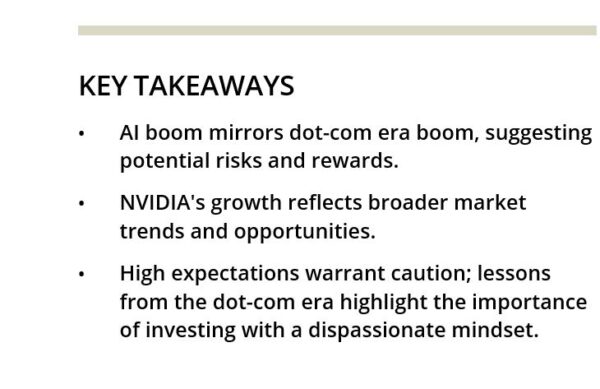Education, Perspectives
Investment Perspective: Back to the Future? Examining the AI Explosion
Apr 17, 2024
Back to all posts.Since generative artificial intelligence (AI) tools became available to the general public in 2022, a clear consensus quickly emerged that AI will have a significant impact on our lives—perhaps even more significant than the internet.
What are the implications of investing in AI and can we apply any lessons learned from the dot-com boom and bust to today’s market?
We are clearly in boom times. NVIDIA, the maker of graphics processing units (GPUs)—the backbone of AI computing—experienced a meteoric rise in recent years. From the day ChatGPT was released on November 30, 2022 to March 31, 2024, NVIDIA’s market cap grew from $400 billion to $2.2 trillion. Other “Magnificent 7” constituents (Apple, Amazon, Alphabet, Microsoft, Meta, and Tesla) include NVIDIA’s largest customers and also collectively outperformed the market.
The AI boom has not been limited to mega caps. Super Micro Computer, which makes servers and storage systems, saw its stock rise over 1,000% from November 30, 2022 to March 31, 2024 and was added to the S&P 500. Even more prosaic businesses touched by AI saw significant gains. Vertiv, which makes power and cooling equipment for data centers, gained almost 500% during the same timeframe.
Déjà Vu All Over Again?
It is natural for investors to wonder what to make of the recent gains of AI and AI-adjacent companies. History doesn’t repeat itself, but it often rhymes; thus, any analogies between the AI and internet booms are imperfect. However, analyzing the dot-com boom can potentially provide useful takeaways for the cautious investor.
Perhaps the most appropriate dot-com boom comparison to NVIDIA is Cisco Systems, which produced routers that made up the backbone of the internet. Cisco’s meteoric rise was more steady; two years after Netscape Navigator introduced the internet to the world, it accounted for less than 1% of the S&P 500. By contrast, less than two years since the release of ChatGPT, NVIDIA is already the third largest stock in the S&P 500, behind only Microsoft and Apple.
Fast forward to the height of the dot-com boom in March 2000 and Cisco comprised more than 4% of the index and traded at over 100x forward earnings. While NVIDIA makes up roughly 5% of the S&P 500, it trades at a much more reasonable multiple of 35x forward earnings.
NVIDIA’s multiple does bake in a surge in earnings. At the end of the first quarter, the consensus projected earnings per share (EPS) of $24.06 for FY 2024—a 98% increase from FY 2023 and more than 600% from FY 2022. Total earnings are projected to grow to $105.3 billion in FY 2024—up 82% from FY 2023 and nearly 300% from FY 2022. If the projection holds, NVIDIA’s compound annual growth since 2019 will be roughly in line with Cisco’s growth from 1995 and 2000.
NVIDIA’s Unique Ecosystem
NVIDIA focuses on the design of its products, and outsources fabrication. Foundries such as Taiwan Semiconductor and Samsung produce its semiconductor wafers, while companies like Micron Technology and SK Hynix supply memory. Contract manufacturers such as Foxconn assemble, test, and package the final products.
NVIDIA’s largest customers include mega cap tech giants. In its last annual report, NVIDIA disclosed that its largest customer represented 19% of its FY 2023 revenues, or roughly $11.6 billion. While the identity of the company was not disclosed, even for a company as large as Microsoft, one of the AI leaders, such an outlay would have represented approximately one third of its capital expenditures (capex) for 2023.
Over the past two years, NVIDIA’s revenue growth significantly outpaced the capital expenditure growth of the other Magnificent 7 companies. In 2022—before the AI boom began in earnest—NVIDIA’s revenues was roughly 16% percent of the capex for the remaining Magnificent 7 constituents. In 2023, it rose to 35%, and the consensus currently projects that to increase to 61% in 2025.
Cisco’s Cautionary Tale
Only time will tell if Wall Street’s expectations were too aggressive. While there is no way of knowing when NVIDIA will cool off, we do know what led to Cisco’s demise. The average nominal investment in communications equipment grew 15.5% in 1995-2000—including 28.6% in 2000 alone—before declining 29% from 2000 to 2002, according to the Bureau of Economic analysis.
All told, Cisco fared much better than the broad industry, with revenues growing around 50% from 1995-2000. When the downturn hit, company revenues declined a more modest 17% in 2000–2002, but shares re-rated sharply, collapsing 90% from peak to trough. Since then, Cisco revenues and earnings have grown at a compounded rate of roughly 5% and 11% per year, respectively.
However, Cisco’s shares still trade below their March 2000 peak. Taking into account dividend distributions, investors that bought Cisco at its peak finally broke even in 2021.
An Imperfect Comparison
As previously noted, any comparison to the dot-com boom is imperfect. For one, NVIDIA’s current valuations are considerably more reasonable. Meanwhile, the tech sector is far less nascent than it was in the late-90s. The dot-com boom saw former leaders such as IBM and Hewlett Packard disrupted by relative upstarts. Investors also torched a lot of capital on start-ups with ill-defined business models, such as sock puppet Super Bowl XXXIV ad star Pets.com.
Today’s tech leaders are cash flow-generating machines; network effects and access to a treasure trove of user data afford them a wide moat. In addition, while an estimated $20+ billion in capital has been invested in private AI companies, pure-play AI presence in public markets has been relatively scarce.
It can be difficult during a boom to project which companies will ultimately succeed over the long-term. Notably, Microsoft was one of the few dot-com market leaders that remains a leader today. Amazon IPO’d in 1997 and struggled through the downturn, with the stock registering a 95% drawdown. Google was founded in 1998, while Facebook wasn’t founded until 2004, after the end of the dot-com boom.
Final Thoughts
We are still in the early innings of the AI revolution and it is possible that the eventual market leaders in AI have not even been formed yet. Just as with the dot-com boom, market exuberance could lead to companies experiencing periods of soaring stock prices, and managers with exposure to these high flying names will post eye-popping performance returns. Investors will most assuredly have opportunities to compound capital and create wealth in this market environment.
However, we believe it is important for investors to remember the cautionary tale of the dot-com boom and avoid letting emotions influence their trades. We recommend that investors consult with their financial advisors to navigate the opportunities and risks of the AI revolution. Caveat emptor. ■
 ARMAN GEVORGYAN
ARMAN GEVORGYAN
Principal/Director, Research – Equity
Indices referenced are unmanaged and cannot be invested in directly. Index returns do not reflect any investment management fees or transaction expenses. All commentary contained within is the opinion of Prime Buchholz and is intended for informational purposes only; it does not constitute an offer, nor does it invite anyone to make an offer, to buy or sell securities. The content of this report is current as of the date indicated and is subject to change without notice. It does not take into account the specific investment objectives, financial situations, or needs of individual or institutional investors. Some statements in this report that are not historical facts are forward-looking statements based on current expectations of future events and are subject to risks and uncertainties that could cause actual results to differ materially from those expressed or implied by such statements. Information obtained from third-party sources is believed to be reliable; however, the accuracy of the data is not guaranteed and may not have been independently verified. Performance returns are provided by third-party data sources. Past performance is not an indication of future results.© 2024 Prime Buchholz LLC